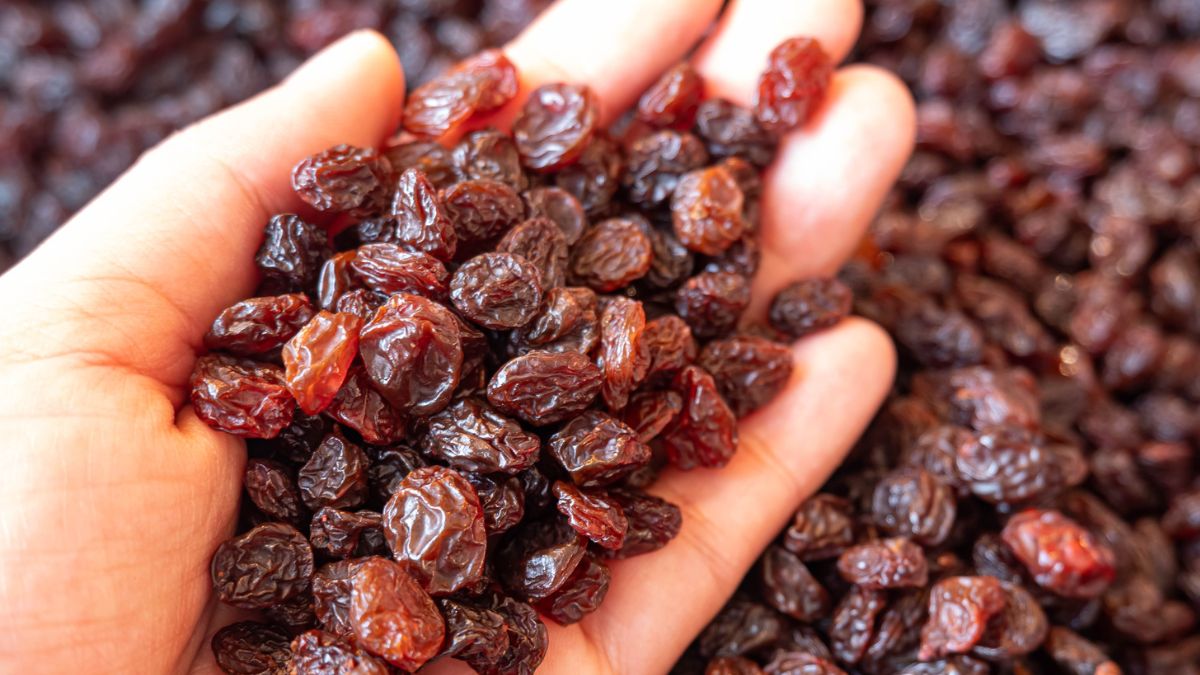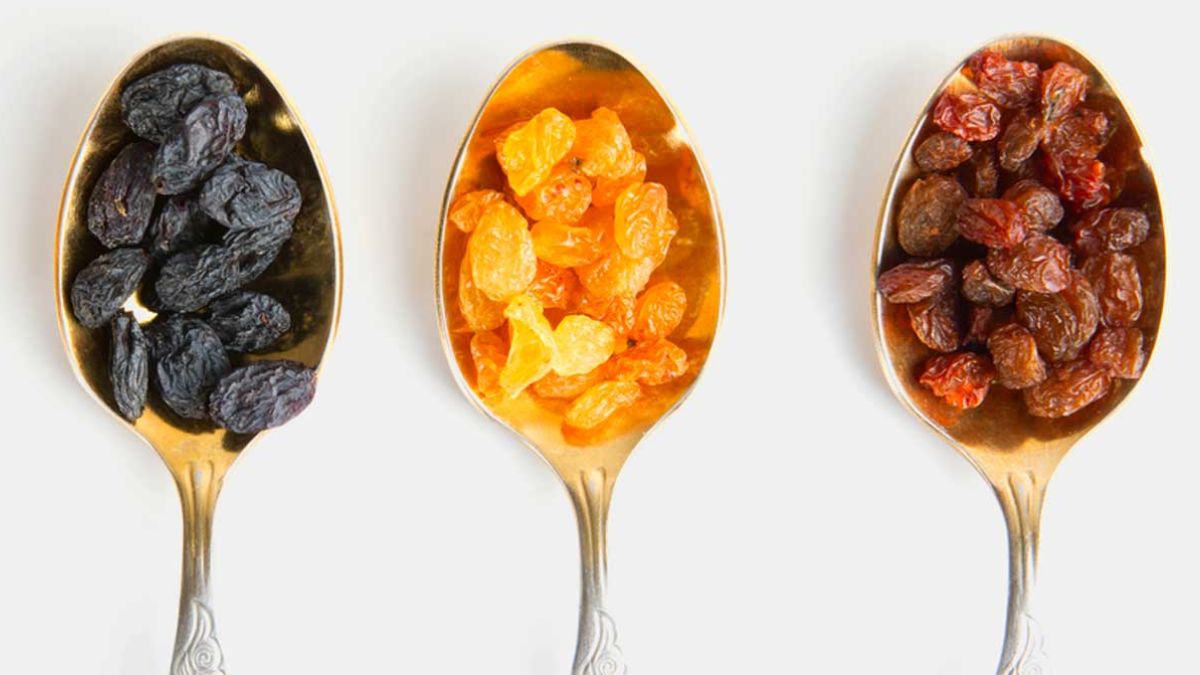Raisins are made from Moscatel grapes (via The Spruce Eats). They are green-skinned white grapes with white flesh. If you want to get technical, raisins are most likely classified as a fruit because they come from one. According to California Raisins, Moscatel grapes are grown on a common vine known as Vitis vinifera. They’re seedless, so drying is a breeze.
During the procedure, the grapes are usually left in the sun. Paper trays are commonly used for drying, but they can also be left on the vine until harvested. They’re housed in wooden containers once they’ve gone from grape to raisin (like a caterpillar to a butterfly), with all stems removed, sorted by size, and then cleaned and washed (via California Raisins). The result is a black, dried, wrinkly fruit that is a fraction of the size of the original grape.
What is a Raisin?
A raisin is created when a grape is dried. Harvesting grapes is the initial stage in raisin production. A cool dip is used to pre-treat the grapes, and this aids in the evaporation of water through the thick grape skin. The grapes are then dried. Sun drying is cheap, but it takes a long time and exposes you to pests. Mechanical drying is a faster and more regulated method that promotes rapid evaporation. When the raisins are dry, they are taken to a processing plant, where any stems or extraneous objects are removed.
What are the Varieties of Raisin?
Natural dark purple grapes and golden sultanas are the most prevalent grape varietals. There are also seedless raisins and the red and flaming type that can be bought at an organic or gourmet market. Because of the way the Thompson seedless grape is dried, the natural raisin is designated “natural.” It’s dried entirely naturally, without any oils or solutions. Golden raisins, also known as sultanas, are created from the same grapes as natural raisins but undergo a different processing method and a sulfur dioxide treatment to give them their rich, golden color.
How to Cook with Raisins?
Raisins should be added to the ingredients as directed in the recipe, and they can be sliced or left whole to make them smaller. Raisins’ high sugar content makes them sweet, but it also causes them to dry up and become gritty after a lengthy storage period. The sugars in the fruit can crystallize, but that doesn’t mean you can’t use them. There are a few methods for reviving dried raisins:
- Blanch the raisins in boiling water to plump them up. Boil the raisins for 10 to 15 minutes or until they begin to expand. Add citrus zest, spices, or liquor to the water for added taste.
- Another approach is to microwave the raisins to soften them. Pour a few tablespoons of warm water over the raisins in a bowl. Microwave for 12 to 15 seconds, then drain any excess liquid and set aside, covered. The raisins should absorb the moisture once they have cooled.
- The raisins can also be resurrected in the oven. Spread the raisins on a cookie sheet between layers of paper towel and bake for 20 to 25 minutes at 200 degrees Fahrenheit. Keep a watchful eye on things. Cooking raisins for too long might have the reverse effect, drying them out even more.
The raisins should be consumed, used in recipes, or refrigerated the same day after being revived.
Where to Buy Raisins?
Raisins can be found at most major supermarkets, and they’re in the baking aisle or the dried fruit section. Most raisins are packaged in boxes or resealable bags, and individual boxes for lunchboxes to large tubs for bulk use are available in various sizes.
It’s challenging to assess freshness by sight because you can’t see the raisins in most packaging. If you squeeze the box and it is soft and squeezable, you have a fair probability of making a solid choice. Rattling is another telling indication. Shake the container vigorously and listen. If raisins are shaken and dried out, they will continue to dry out, shrivel up, stiffen, and rattle around in a box or bag.
How to Store Raisins?
It’s crucial to preserve raisins correctly so that they don’t dry up too rapidly. Raisins should be stored in an airtight container or bag in a cool, dark place. The majority of kitchen cabinets are overheated. They should only be kept on the shelf for a month at the most, after which time they will begin to dry out, discolor, and lose vitamins. Raisins are also known to attract pests, so inspect them for insect activity before using them. For storage of more than a month, refrigeration is recommended. Raisins can last six months to a year in a properly sealed container.
How to Eat Raisins?
Raisins can be eaten straight from the package or added to some meals, and there are endless alternatives, from breakfasts to desserts to savory feasts. Here are some suggestions for including more raisins in your diet:
- Try this flourless version of famous oatmeal raisin cookies for a healthier alternative. Look over the recipe.
- Raisins are a delicious addition to almost any sweet spread. Make this cinnamon raisin cashew butter if you’re looking for something new to try. You can use another nut instead of cashews if you don’t like them. Look over the recipe.
- Raisins and juicy apples add flavor to chicken salad. Look over the recipe.
Granola is simple to produce at home, contrary to popular opinion. Raisins are a fantastic addition to any granola recipe. This cinnamon raisin granola recipe can easily be prepared gluten-free or vegan. Look over the recipe. - Muffins with pumpkin, raisins, and flaxseed are high in fiber. Look over the recipe.
- Adding raisins to your pasta might seem weird. The Mayo Clinic’s experts created this spaghetti meal using spinach, garbanzo beans, and raisins. It contains a lot of iron, protein, and fiber. Look over the recipe.
What do they Taste Like?
Before you bite into a raisin for the first time, you should realize that they don’t taste anything like grapes. According to The Spruce Eats, grapes are juicier, more significant, have smooth skin on the outside, and are less sweet. The sugar in the fruit is concentrated during the drying process.
Golden and brown raisins are the two most common varieties, and each has a distinct flavor profile. According to the Khoshbin Group, golden raisins are fruitier, while brown raisins are sweeter and grainier. Brown raisins are sweeter than white raisins because of the drying process.
Golden is oven-dried and sulfur dioxide-treated to keep it golden. Brown grapes are typically dried for two to four weeks in a vineyard (via Khoshbin Group). According to Epicurious, they come from the same type of grapes, the green Thompson Seedless, even though they appear and taste different.
Conclusion
Grapes that have been dried are known as raisins. They can be prepared from various grapes, and the flavors and textures of the raisins vary depending on the grape. Raisins are dried in a variety of methods. Natural-dried raisins are dark in color and are dried in the sun, and it takes around three weeks to dry completely. Raisins manufactured with various drying procedures or from various sorts of grapes may have different names. White raisins are a raisin cultivar with white color. They’re also known as golden raisins or muscats. Unlike the traditional sun-dried raisin, white raisins are dried in the oven. They are less sweet than sultanas and can be used with “regular” raisins.
A raisin is a grape that has been dried. The sun or a mechanical procedure can dry the grapes, resulting in raisins. These dried fruits are grown and consumed all over the world. Raisins can be eaten fresh or cooked and baked. Raisins can be eaten straight from the jar, added to trail mix or oatmeal, or baked into desserts. They are frequently soaked in juice or alcohol before being incorporated into baked items since they absorb much liquid. Raisins, like other dried fruits, are incredibly delicious. Because raisins were once grapes, they have a sticky stickiness and may have moist interiors. Raisins that have dried out too much might have a gritty texture. In most recipes, different types of raisins can be used interchangeably. Try dates, prunes, or dried cranberries instead of raisins to replace them. To prepare the dates and prunes, slice them into raisin-sized pieces.


